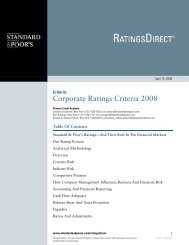European Infrastructure Finance Yearbook - Investing In Bonds ...
European Infrastructure Finance Yearbook - Investing In Bonds ...
European Infrastructure Finance Yearbook - Investing In Bonds ...
Create successful ePaper yourself
Turn your PDF publications into a flip-book with our unique Google optimized e-Paper software.
PROJECT FINANCE/PUBLIC-PRIVATE PARTNERSHIPS<br />
Publication Date:<br />
April 13, 2007<br />
Primary Credit Analysts:<br />
Karim Nassif,<br />
London,<br />
(44) 20-7176-3677<br />
Terry A Pratt,<br />
New York,<br />
(1) 212-438-2080<br />
Secondary Credit Analyst:<br />
Michael Wilkins,<br />
London,<br />
(44) 20-7176-3528<br />
122 ■ NOVEMBER 2007<br />
CREDIT FAQ: RECENTLY UPGRADED NAKILAT<br />
PROVIDES CASE STUDY FOR CREDIT ANALYSIS OF<br />
LNG SHIPPING PROJECTS<br />
Our first-ever public rating on a liquefied<br />
natural gas (LNG) shipping entity was<br />
recently raised when Qatar-based Nakilat<br />
<strong>In</strong>c. was upgraded to ‘A+’ with a stable outlook.<br />
The rating on Nakilat, a wholly owned subsidiary<br />
of Qatar Gas Transport Co. Ltd. (QGTC), was<br />
raised following the upgrade of the State of Qatar<br />
(AA-/Stable/A-1+). This reflected our continued<br />
expectation of strong potential extraordinary<br />
sovereign support for Nakilat in an event of<br />
stress. Since then, Standard & Poor’s Ratings<br />
Services has received several questions concerning<br />
our rating analysis of LNG shipping financings.<br />
Currently Nakilat is the only publicly rated LNG<br />
shipping entity and so, understandably, it<br />
represents the best case study of our rating<br />
approach. This article attempts to answer the<br />
most frequently asked questions we have been<br />
receiving concerning Nakilat and our general<br />
credit analysis of LNG shipping financings.<br />
Further information can also be read in the article<br />
titled “Global LNG Shipping Projects May Be On<br />
Course For <strong>In</strong>vestment Grade,” published on<br />
March 6, 2006, on RatingsDirect.<br />
Frequently Asked Questions<br />
What are the major factors that underpin<br />
Standard & Poor’s approach to rating LNG<br />
ship financings?<br />
Generally our approach is to consider LNG<br />
shipping as an integral part of the complete LNG<br />
supply chain, which starts from natural gas<br />
development and production from the gas field,<br />
moves through liquefaction of the natural gas,<br />
and ends with regasification at the import<br />
terminals and then sale to the end markets. The<br />
two key elements that underpin our approach are<br />
counterparty risk and the legal structure<br />
(including construction and charter agreements).<br />
Counterparty risk.<br />
One of the key elements determining the rating<br />
for LNG ships is related to counterparty risk,<br />
specifically to the upstream project producing the<br />
LNG. <strong>In</strong> most, if not all, cases the project is the<br />
source of payments to the shipper. If the project<br />
fails, the alternative use for the LNG ships is still<br />
limited given the absence of a large LNG spot<br />
market. As a result, the credit quality of the<br />
underlying LNG project usually provides one of<br />
the key constraints for the rating of the LNG ship<br />
STANDARD & POOR’S EUROPEAN INFRASTRUCTURE FINANCE YEARBOOK<br />
financing. The upstream project is often also the<br />
charterer under the charter agreement. If there is<br />
an alternative charterer other than the project<br />
company the credit quality of the alternative<br />
charterer would also be important, because it<br />
provides a measure of the certainty and reliability<br />
with which cash flows will be earned by the vessel<br />
owners under the charter agreement for the<br />
purposes of repaying debt.<br />
There is also a counterparty risk inherent in the<br />
construction of ships. The credit quality,<br />
experience, transaction support through thirdparty<br />
liquidity, and reputation of the shipbuilder<br />
are also essential elements, therefore, in the<br />
overall analysis of an LNG shipping project.<br />
Legal structure (including construction and<br />
charter agreements).<br />
The second key element in our analysis is the risk<br />
to lenders that arises based on the charterparty<br />
contract and construction contracts. For an<br />
investment-grade rating we would expect the<br />
charterparty contract to last through the debt<br />
tenor and guarantee availability-based fixed<br />
payments with inbuilt escalation clauses to cover<br />
growing operating and material costs. For<br />
construction contracts we would expect fixedprice,<br />
date-certain arrangements with established<br />
shipbuilders coupled with shipbuilder-completion<br />
guarantees.<br />
Most LNG ship financings we have reviewed<br />
have been structured as projects and have used<br />
special purpose entities (SPEs). There are specific<br />
contracts and documentation for single ships,<br />
although often several ships are operated as a<br />
group. <strong>In</strong> effect, the financings have involved a<br />
portfolio of ships with the contractual nature<br />
being determined on a ship-by-ship basis. For the<br />
single ships we look to our project finance criteria<br />
in analyzing underlying risks given the single-asset<br />
nature of the SPEs and the contractual structure.<br />
<strong>In</strong> many cases, however, there is a holding<br />
company sitting on top of the SPE that ultimately<br />
owns multiple ships, albeit through an SPE<br />
structure. The review of the holding company as<br />
part of a portfolio review might, therefore,<br />
require more of a corporate analysis. Ultimately, a<br />
portfolio of LNG ships is often presented as a<br />
hybrid structure featuring both project and<br />
corporate features. Our rating analysis, therefore,<br />
has to take into account these unique features.



